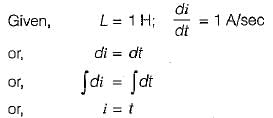Test: Capacitors & Inductors - 1 - Electrical Engineering (EE) MCQ
15 Questions MCQ Test GATE Electrical Engineering (EE) Mock Test Series 2026 - Test: Capacitors & Inductors - 1
An Inductor works as a ________ circuit for DC supply.
A power factor of a circuit can be improved by placing which, among the following, in a circuit?
Which among the following equations is incorrect?
What is the value of capacitance of a capacitor which has a voltage of 4V and has 16C of charge?
What is the total capacitance when two capacitors C1 and C2 are connected in series?
A resistance of 7 ohm is connected in series with an inductance of 31.8mH. The circuit is connected to a 100V 50Hz sinusoidal supply. Calculate the current in the circuit.
The equivalent circuit of the capacitor shown below is:

The strength of current in 1 Henry inductor changes at a rate of 1 A/sec. The magnitude of energy stored in the inductor after 3 sec is:
The current and voltage profile of an element vs time has been shown in given figure. The element and its value are respectively:

Figure shown below exhibits the voltage-time profile of a source to charge a capacitor of 50 μF. The value of charging current in amperes is:

The equivalent capacitance across the given terminals A-B is:

The charging time required to charge the equivalent capacitance between the given terminals a-b by a steady direct current of constant magnitude of 10 A is given by:

An ac voltage of 220 V is applied to a pure inductance of 50 H. If the current is 5 A, the instantaneous value of voltage and current will be respectively given by:
The voltage and current through a circuit element is v= 100 sin (314 t + 45°) volts and i = 10 sin (314 t - 45 ° ) amps.
The type of circuit element and its value will be respectively:
The equivalent inductance for the inductive circuit shown below at terminal “ 1 - 2 ” is:

|
26 docs|257 tests
|
|
26 docs|257 tests
|



























